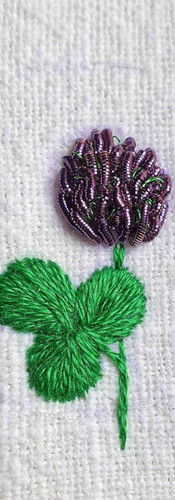Destroyed purls?
- Štikarca
- Sep 15, 2022
- 2 min read
What to do with destroyed purls
Let's play Have you ever :)
Have you ever embroidered?
Have you ever bought purl wires?
Have you ever got them destroyed?
During embroidering it often happens that some of the purls get destroyed. They get stretched, they are not compact enough and as a result, they are unusable for traditional embroidery.
As I am cautious with my purls and only seldom throw anything away, I wanted to use destroyed purls also.

But how to use them?
Especially, what to do with purple-colored smooth purls? The colour is gorgeous, it even changes colour under various lighting conditions.
After a while, I came up with the idea of a clover flower.
The destroyed purple purls were stretched even more, mixed with destroyed and stretched green purl, clumped together to form the right-sized circle and carefully stitched to the base (here ramie fabric). A translucent thread is recommended for stitching because it isn't visible on the fabric.

After the base was stitched, a beautiful smooth purl was stitched with long and short stitches. I let the base peak through to create an impression of green on the flower head. The purls formed the gorgeous bulbous head of the clower flower.
It was formed in a clover pendant later on.
Other uses of destroyed wires
1. Stretched wire can be used as an individual element.
2. Stretched wire can be used as a decoration to hide the uneven edges of the embroidery.
3. Specific textures can be created with stretched wires, for example, imitation of destroyed area, or crumbled texture etc.
Interesting facts
What is bouillion or smooth purl?
»Bouillion or canetille is a tubular fomration from a very thin spiral shaped metal wire. There are many kinds of bouillion, smooth or check among others.« (Niklsbacher-Bregar, 1970, str. 144)
Slovenian author uses the expression curly bouillion for the check purl.
Literature:
Niklsbacher-Bregar, N. (1970). Zlate vezenine. V M. Makarovič, & N. Niklsbacher-Bregar, Ljudske vezenine na Slovenskem (str. 137-152). Ljubljana: Centralni zavod za napredek gospodinjstva, Etnografski muzej.











Comments